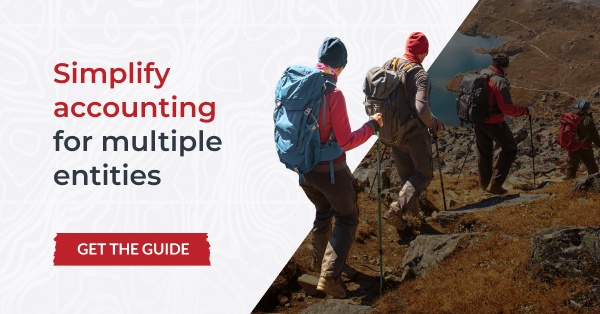Multi-fund accounting best practices for nonprofits

While a large nonprofit organization with a broad focus is bound to have multiple funds, even smaller and mid-sized nonprofits often have multiple programs, grants, and donor designations, all benefiting from separate financial tracking.
Having the right multi-fund accounting setup is integral to earning and keeping stakeholders' trust and improving efficiency, giving you more time to focus on your organization's mission.
Here are a few best practices for multi-fund accounting for nonprofits and how multi-entity accounting software helps you implement them.
The use cases for multi-fund accounting
There are several scenarios in which separating financial data for different aspects of your nonprofit makes sense, including:
Impressing grantmakers with effective use of funds
While general operating grants have increased as a result of the pandemic, grantmakers often give money to nonprofits to accomplish specific goals within set time periods.
Accomplishing those goals and being transparent about who benefits from the funds can establish your organization as trustworthy financial stewards and increase your chances of receiving future grants.
Turning initiatives into fully funded projects
Even within a single-mission nonprofit, there may be different programs. For example, a women's shelter may have a program that provides business clothes so residents can go on job interviews. Having separate accounting for this initiative may help when seeking donors or grantmakers to provide continued funding.
Honoring donors' wishes
A charity that provides wide-ranging assistance may give donors a say in where their funds go. A nonprofit working in developing nations, for example, may allow donors to choose whether their gift is put toward housing, food assistance, or job development. Separately tracked funds allow you to demonstrate that the money is being used as intended.
Supporting fellow organizations
One of the most significant use cases for multi-fund accounting is for organizations that disburse funds to smaller nonprofits. A charity that raises money to help cancer patients, for example, will want to track research funding separately from money given to organizations that provide patients with direct help, such as assistance paying medical bills or transportation to doctor appointments.
Best practices for multi-fund accounting
While there are plenty of reasons for a nonprofit to establish multiple funds, deciding how to structure multi-fund accounting isn’t always straightforward. Here are some best practices.
Streamline processes
According to BKD CPAs & Advisors' 2022 State of the Nonprofit Sector report, 58% of nonprofit survey respondents experienced a budget shortfall and 71% were hampered by staffing shortages. Yet 65% experienced an increase in demand for their services or programs. In other words, nonprofits are being asked to do more with less.
For nonprofits managing multiple funds, an accounting solution with multi-entity accounting capabilities, including a shared chart of accounts, is essential. Without it, your organization could waste hours logging in and out of different databases and manually entering invoices and receipts into each one. It's a problem the British Institute of Innkeeping (BII) experienced prior to switching to Gravity’s multi-entity accounting software.
The finance team spent hours each week on repetitive data entry within its previous software, Sage 50cloud. With Gravity's multi-entity accounting, "you just select the entity you want to look at and carry on working," said BII Head of Finance Shila Singh. The BII also worked with Gravity to create automated workflows for managing purchase order approvals.
Use cloud-based accounting software
Using cloud-based software allows your team to manage multi-fund accounting anywhere.
If your nonprofit builds affordable housing, for example, your project manager can enter expenses from the build site. The leader of your mentoring organization's afterschool program can update her budget while supervising snack time. Time spent traveling to the office solely to use the accounting software is time not spent furthering your organization's mission. Auditors also appreciate the opportunity to access nonprofits' books remotely.
Consolidate financial reports
Choosing accounting software with the ability to compile consolidated financial reports — without the need to copy and paste each data point from each entity into a separate spreadsheet — is a best practice for any multi-entity organization. The time it saves carries even more significance for a nonprofit because each employee has so many other responsibilities. The employee who spends hours compiling a multi-fund financial report each month could spend that time planning a fundraiser or working within the community. Multi-entity reporting capabilities could change your reporting timetable significantly.
Invest in business intelligence
Robust business intelligence makes it easier to illustrate that you're putting donors’ money to good use. For nonprofit donors, knowing that the organization is being a good steward of their money is part of their return on investment. A business intelligence solution such as Microsoft Power BI, which is available to Gravity users, is easy to use and offers numerous options for presenting financial information in a visually appealing way.
Business intelligence also helps your leadership and board identify new opportunities for growth and identify potential concerns so you can proactively address them. For instance, if you notice a significant drop in donations for one of your funds or you see a spike in utility costs across your locations, you may consider a new marketing campaign to increase donations or closing the offices on Fridays to reduce costs.
Why follow best practices for multi-fund accounting?
While there's no downside to any organization achieving greater efficiency and transparency, following accounting best practices comes with specific benefits for nonprofits.
It's required by GAAP
In 2016, the FASB announced what the Journal of Accountancy called "the biggest change to not-for-profit financial reporting in 25 years." In part, ASU No. 2016-14 reduced the number of net asset classifications from three to two, though the Journal of Accountancy recommends having different accounts for each fund or endowment even if assets are still invested in a pool.
Another change, according to the publication: "Not-for-profit organizations are now required to provide an analysis of expenses by their natural classification (such as salaries, rent, and depreciation) as well as their functional classification (program, management and general, and fundraising) in one location."
It increases accountability and trust
When your donors can clearly see how you’re using their money to fulfill your mission, they’ll be more likely to support you in the future. Multi-fund accounting makes it easier to demonstrate the impact of specific types of donations. You can show donors how many meals they helped to fund, how many emergency shelters they helped to staff during a storm, or how many children could stay in school because of your scholarship fund. And you don’t have to wait until the annual report to share these success stories. You can include them in monthly newsletters, thank you letters at the end of a campaign, or in TV and radio ads.
You'll earn the trust of key stakeholders
Whereas shareholders in a for-profit business may accept some seemingly trivial expenses as long as you continue making them money, nonprofits don't have that leeway. Donors, grantmakers, and boards expect the bulk of funds to go directly toward your organization's mission while keeping administrative costs to a minimum. As The NonProfit Times puts it: "funders want to pay for the water to put out a fire, but not the hose it takes to deliver the spray."
This is where multi-fund accounting software is so beneficial. It promotes trust while achieving operational efficiency that allows you to run a lean administration.
The benefits of Gravity’s multi-fund accounting software
Designed especially for multi-entity (or multi-fund) organizations, Gravity Software can help you save valuable time while providing the data transparency that's so important in the nonprofit sector. With Gravity, you can:
- Keep separate financial information for each fund within the same database. No more logging into and out of different databases or paying for multiple instances of the same software.
- Compile consolidated financial reports without the need to copy each piece of information from each fund into a separate spreadsheet.
- Further streamline your financial reporting through our integration with Jet Reports.
- Effectively manage non-monetary donations such as property bequests with our asset management advanced functionality.
- Achieve peak operational efficiency through automated workflows using Microsoft Power Automate.
Gravity also offers a special discount for nonprofits. And, if your organization has a global reach, Gravity boasts robust multi-currency accounting capabilities.
Schedule your demo today and learn how Gravity can help your nonprofit organization advance its mission with multi-fund accounting software.
Gravity Software
Better. Smarter. Accounting.


